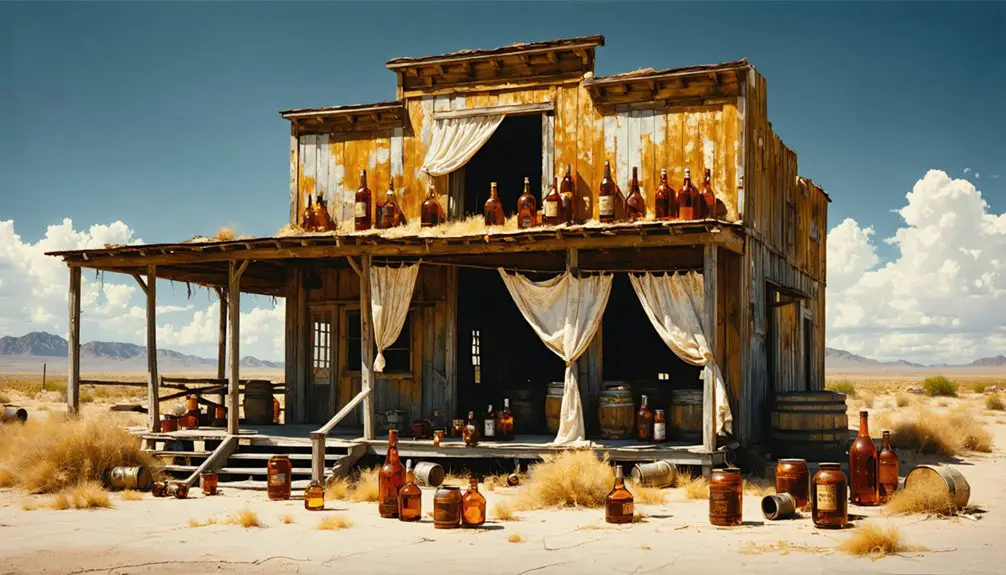You’ll find Albuquerque’s ghost town remains in Gonzales County, Texas, where Samuel McCracken and Henry Hastings established their frontier dream in 1857. The settlement thrived initially with a cotton gin, blacksmith shop, mercantile store, and saloon serving as essential community hubs. Despite early success, transportation challenges and the railroad’s eastward placement led to the town’s gradual decline. By 1912, Albuquerque stood abandoned, though its story of frontier ambition and ultimate isolation holds deeper secrets.
Key Takeaways
- Established in 1857 as a frontier settlement in Gonzales County, Texas, with essential businesses including a cotton gin and blacksmith shop.
- Economic decline began when railroad tracks were placed east of town, isolating it from major transportation routes.
- The town became completely abandoned by 1912 as businesses and residents migrated to the more prosperous nearby Union Valley.
- Key establishments included a saloon, mercantile store, cotton gin, and post office before its abandonment.
- Historical preservation relies on archival records and documents, as physical structures no longer remain in the ghost town.
The Founding Years: McCracken and Hastings’ Vision
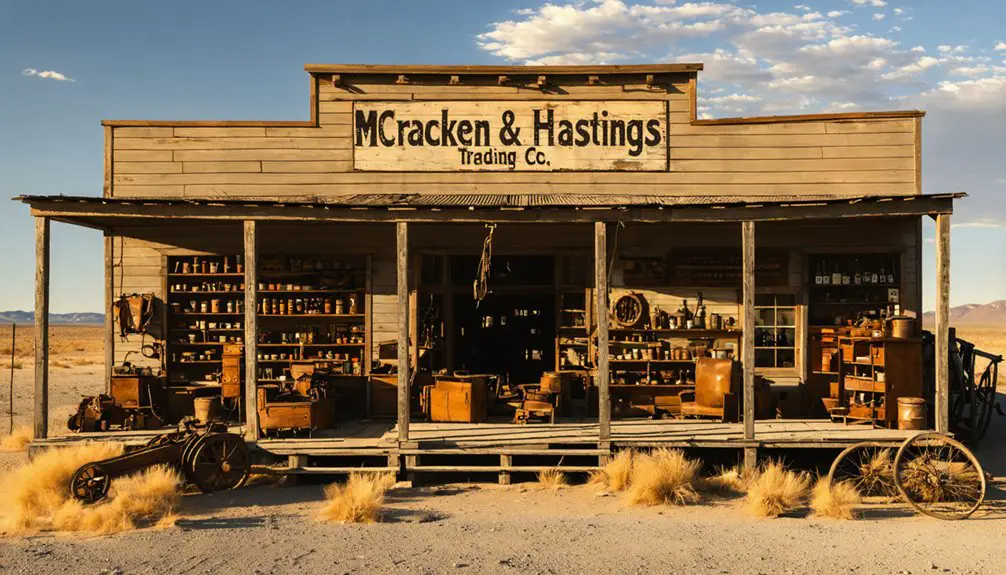
Two ambitious entrepreneurs, Samuel McCracken and Henry Hastings, established Albuquerque, Texas in 1857, initially believing they’d settled in Wilson County before discovering their location was actually in Gonzales County.
The founders’ aspirations centered on creating a self-sustaining frontier settlement that would serve the region’s agricultural needs while fostering community growth. Unlike today’s largest city in New Mexico, their town would not survive the test of time.
Their community vision emphasized practical infrastructure development, including essential businesses like a general store, saloon, blacksmith shop, and cotton gin. Like the Spanish settlers of 1706 who established irrigation systems, they focused on developing sustainable resources for their community.
You’ll find their careful planning reflected in the establishment of an elementary school, demonstrating their commitment to attracting families and ensuring the town’s longevity.
Early Life in a Texas Frontier Settlement
Life in Albuquerque’s early days centered around essential pioneer activities like cotton ginning, blacksmithing, and trade at the local store and saloon.
You’d find settlers gathering regularly at these establishments not just for business but for social connection, making the saloon particularly important as the town’s primary meeting spot.
The arrival of the transcontinental railroad in 1880 transformed the town by bringing many Italian-American families who established thriving businesses.
Similar to the nearby settlement of Dawson coal mines, the town relied heavily on natural resource extraction for its economic growth.
While the community tried maintaining order through local governance, you’d witness the challenging nature of frontier justice through violent incidents like the 1871 murder of Special Policeman Green and Sheriff Helm’s 1873 assassination.
Daily Pioneer Activities
When settlers first arrived at the Texas frontier, they faced grueling daily routines that began before sunrise and stretched well past sunset. You’d find yourself tackling essential pioneer chores immediately – feeding livestock, milking cows, and separating cream before breakfast.
Throughout the day, you’d work the fields, repair tools in the blacksmith shop, or tend to crops requiring constant irrigation from nearby water sources. Pioneers had to develop dry farming techniques to overcome the harsh conditions and limited rainfall. Living near military outposts was essential as Comanche warriors frequently raided settlements.
Women’s daily routines centered on converting raw materials into necessities. You’d spend hours churning butter, preserving food through canning or smoking, and creating clothing from wool you’d card and spin yourself.
As daylight faded, you’d rely on precious oil lamps sparingly. Every Monday brought an intense concentration of tasks – cleaning, organizing supplies, and preparing food stores for the week ahead.
Social Life and Gatherings
Despite the demanding pioneer routines, social gatherings served as bright spots in frontier life at Albuquerque, Texas. You’d find residents congregating at key establishments like the saloon, mercantile store, cotton gin, and post office, where news and conversation flowed freely.
The town’s social resilience showed through various community gatherings, from informal dances to outdoor musical performances. Much like the town of Dawson, which featured a company-built movie theater for entertainment, these events brought the community together. Their all-night parties and dances rivaled those of other frontier towns like Guadalupe.
Family networks, particularly the McCrackens and Hastings, formed the backbone of social life, hosting celebrations and fostering cooperation.
Even during the turbulent times of the Sutton-Taylor feud and violent incidents like Jack Helm’s killing, these bonds persisted.
While conflicts occasionally disrupted public gatherings and created tension, the town’s social fabric remained intact through the shared spaces of the school, local businesses, and impromptu meeting spots.
Law and Order Challenges
The untamed nature of frontier justice in Albuquerque, Texas emerged clearly after its 1857 establishment, as the settlement’s modest law enforcement structure struggled to maintain order.
You’d find special policemen and deputies working under mayoral authority, but their effectiveness was limited. The notorious Sutton-Taylor feud brought violence directly to town, with outlaw J.W. Hardin killing Texas Special Policeman Pvt. Green in 1871 and Sheriff Jack Helm in 1873. The town’s dangerous reputation grew when Hardin and Jim Taylor boasted about killings afterward. The violence and instability continued until the town’s final decline in 1883.
Without strong formal law enforcement, you’d see residents turning to vigilante justice and armed standoffs to settle disputes. The blurred lines between lawmen and criminals created deep distrust, while jurisdictional confusion between Wilson and Gonzales counties further weakened official oversight.
Key Structures and Town Layout
Albuquerque’s key structures formed a compact settlement around the Clear Fork of Sandies Creek, strategically positioned two miles south of the junction between Gonzales, Wilson, and Guadalupe counties.
The town layout centered on essential buildings established by the founding Hastings and McCracken families, including a boarding house and blacksmith shop.
You’d have found the post office, opened in 1870, serving as a crucial communication hub until 1883. The mercantile store and saloon became the heart of community life after the Civil War, while the cotton gin supported local agriculture.
An elementary school operated through the 1870s and 1880s, reflecting the town’s family-oriented nature. Without railroad access, the town relied on road and creek-based transportation, ultimately contributing to its isolation and eventual decline by 1912.
Notable Events and Local Legends
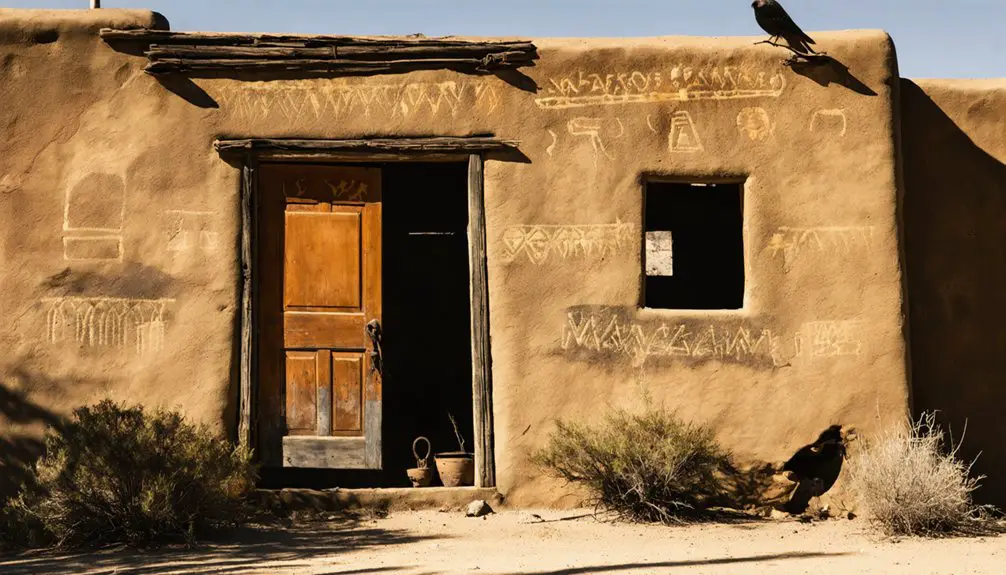
Within this seemingly quiet settlement lay a dark history of violence and legend, marked by infamous outlaws and deadly feuds of the Old West.
You’ll find the town’s darkest chapter began in October 1871, when notorious outlaw John Wesley Hardin killed Texas Special Policeman Pvt. Green. The violence escalated when Hardin assassinated Sheriff Jack Helm in 1873, a killing that became deeply woven into local folklore.
During violent confrontations, Hardin and his gang terrorized townspeople at gunpoint, while the ongoing Sutton-Taylor feud brought additional bloodshed to the streets.
The town’s naming itself carries historical weight, linked to South Texans who served under Henry H. Sibley in New Mexico.
These events shaped Albuquerque’s reputation and ultimately contributed to its abandonment, leaving behind tales of cursed grounds and unsettled spirits.
Economic Activities and Trade Relations
Founded in 1857 by Samuel McCracken and Henry Hastings, Albuquerque initially thrived as a small but essential trading hub centered around its cotton gin, blacksmith shop, mercantile store, and saloon.
The town’s trade dynamics revolved primarily around agricultural activities, with cotton processing and blacksmith services supporting local farmers and ranchers.
Without railroad access, you’d have found the town relying heavily on local roadways and Clear Fork of Sandies Creek for transportation.
The post office’s operation from 1870 to 1883 marked the peak of Albuquerque’s commerce.
However, economic shifts favored nearby Union Valley, located just two miles south. As businesses and trade gradually migrated to Union Valley, Albuquerque’s isolation and limited infrastructure led to its eventual abandonment by 1912.
The Role of Cotton in Town Development
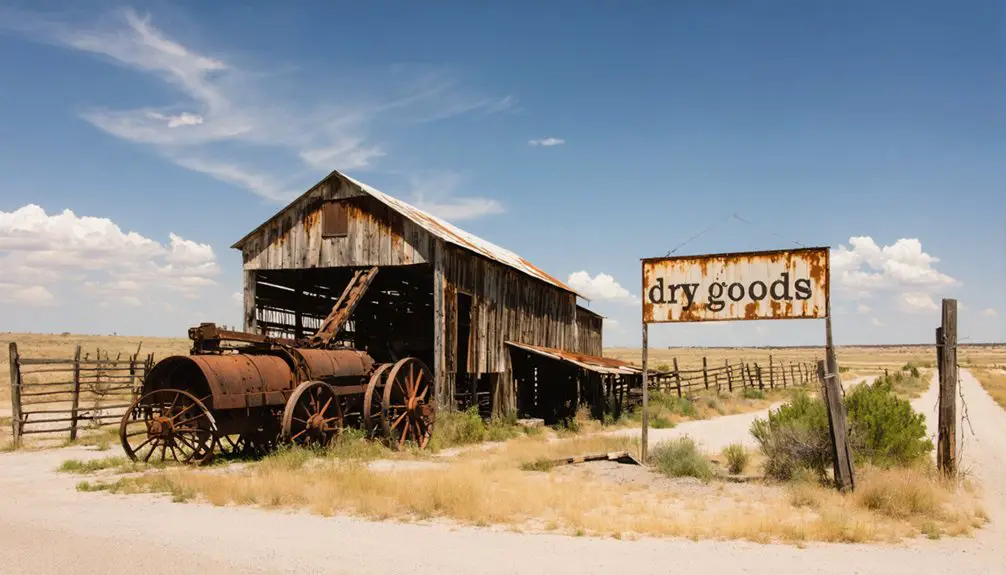
As Spanish missionaries first introduced cotton cultivation to Texas in the 18th century, they laid the groundwork for what would become Albuquerque’s economic cornerstone.
Spanish missionaries brought more than faith to the Southwest – their cotton cultivation seeded Albuquerque’s future economic foundation.
You’ll find that cotton’s influence rapidly expanded after 1821, when Anglo-American settlements transformed the region’s agricultural landscape.
The economic impact of cotton shaped every aspect of Albuquerque’s development. Cotton’s profitability attracted settlers, merchants, and workers, driving the town’s growth and infrastructure.
You’d have seen a bustling community where cottonseed mills provided jobs, while the railroad facilitated trade of raw cotton and processed goods.
Technology like the cotton gin and irrigation systems boosted production efficiency, cementing Albuquerque’s position in the broader cotton economy.
The town became a crucial node in regional trade networks, though its prosperity remained closely tied to cotton’s market fluctuations.
Transportation Challenges and Isolation
While Albuquerque’s growth hinged on railroad development, the placement of tracks east of Old Town created significant transportation hurdles for residents.
You’d find mule-drawn trolleys and later electric streetcars bridging the gap between Old Town and New Town until the late 1920s, when a limited bus system took over.
Geographic barriers, including the Rio Grande’s flooding and surrounding lava flows, forced complex transportation methods like toll roads and stagecoach routes through places like Ozanne and Phillips Crossing.
The region’s transportation challenges intensified as rail lines were abandoned, particularly affecting settlements like Glenrio along the Texas-New Mexico border.
When Interstate 40 replaced Route 66, it bypassed many communities, leaving them increasingly isolated and ultimately contributing to their decline.
Impact of Post Office Closure
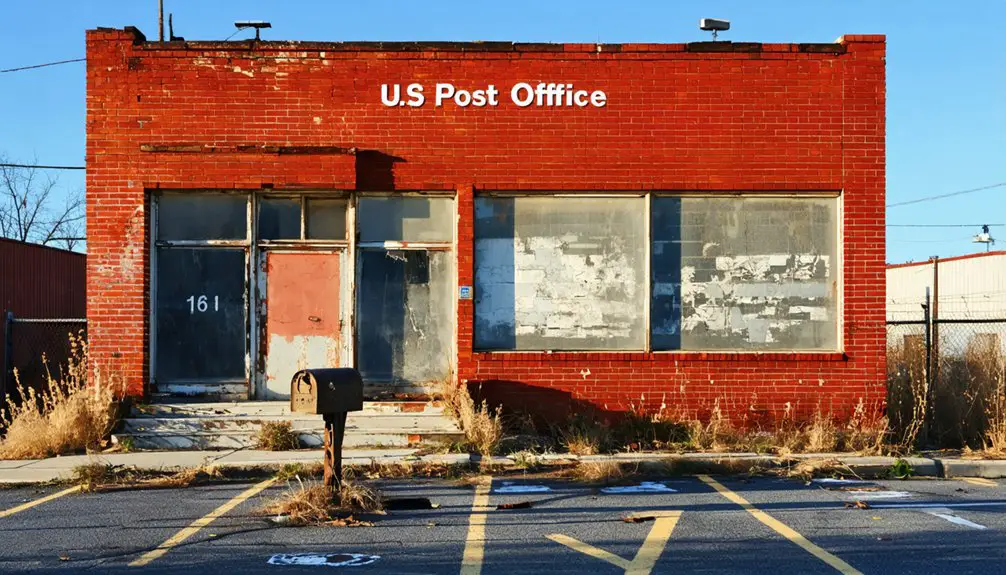
The closure of Albuquerque’s post office in 1883 marked a pivotal turning point in the town’s decline. You’d have seen immediate disruptions to mail delivery and trade, forcing residents to travel greater distances for basic postal services.
The post office had served as more than just a mail hub – it was your community’s gathering place and symbol of prosperity.
Post offices were the beating heart of 19th century towns, where community spirit and economic vitality intertwined.
The shutdown triggered a cascade of economic setbacks. Your local businesses, including the blacksmith, store, and cotton gin, suffered from decreased commercial activity.
As surrounding towns with active postal services flourished, you’d have witnessed Albuquerque’s community decline accelerate. Without this essential institution, social bonds weakened, population dwindled, and business activities shifted to neighboring Union Valley.
The post office closure foreshadowed the town’s eventual abandonment by 1912.
The Gradual Path to Abandonment
Despite Albuquerque’s promising beginnings in 1857, several key factors converged to seal the town’s fate. The lack of railroad access proved devastating, as you’d have seen trade and commerce shift to nearby Union Valley, which enjoyed rail connections.
This economic stagnation triggered a chain reaction – businesses you once found thriving, like the cotton gin, blacksmith shop, and saloon, gradually shuttered their doors.
The community decline accelerated as families sought better opportunities elsewhere, particularly in the 1880s. You’d have witnessed the town’s social fabric unravel as schools closed and community gatherings dwindled.
Adding to these challenges, confusion over whether Albuquerque belonged to Wilson or Gonzales County complicated administrative support, further hastening its transformation into a ghost town.
Historical Preservation and Modern Documentation
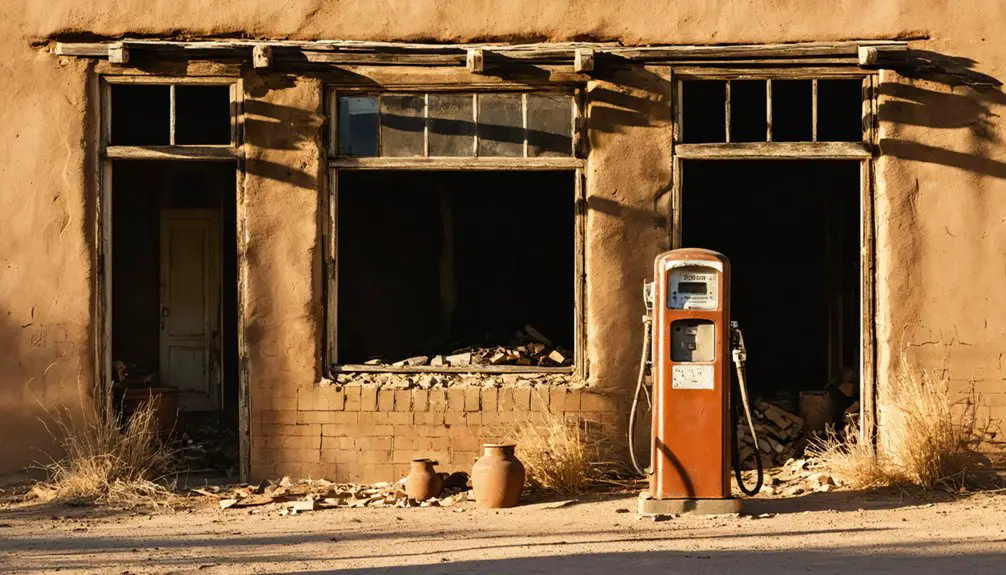
Modern preservation efforts for Albuquerque face significant challenges due to the town’s complete abandonment by 1912. The historical significance of this Texas ghost town primarily survives through archival records and historical documents, as physical structures have long since disappeared.
You’ll find documentation of Albuquerque’s past through:
- Post office operation records from 1870-1883
- Early settler accounts from the Hastings and McCracken families
- County surveys and boundary records from 1914
- Historical newspaper archives covering violent events
- Digital mapping coordinates at 29.34833°N, 97.84278°W
The preservation challenges stem from natural degradation, limited archaeological evidence, and minimal funding for ghost town research.
Today, researchers rely on GIS technology, historical societies, and academic studies to piece together Albuquerque’s story, though its physical remnants have largely vanished from the Texas landscape.
Frequently Asked Questions
Are There Any Surviving Photographs of Albuquerque, Texas From Its Active Period?
Lost in time’s shadows, you won’t find surviving historical photography from the town’s active period. Despite extensive archival research, any photos remain undiscovered, with most records mixing up New Mexico’s Albuquerque instead.
What Happened to the Residents After the Town Was Abandoned?
You’ll find most residents migrated to Union Valley, just two miles south, where commerce thrived. Others scattered across Gonzales County, leaving their ghost town legacy as they sought better economic opportunities.
Were There Any Native American Settlements in the Area Before?
While native tribes inhabited Texas, you won’t find specific records of settlements at this location. The area’s settlement history primarily shows indigenous groups like Caddos and Kickapoo in broader surrounding regions.
What Was the Peak Population of Albuquerque During Its Most Prosperous Years?
You’ll find no exact population records during the peak prosperity years, but historical significance suggests the ghost town likely reached no more than a few hundred residents at most.
Are There Any Descendants of Original Settlers Still Living Nearby Today?
Like searching through your inbox for descendant stories, you’ll find no conclusive evidence of original settler families nearby today, though family histories suggest some might remain in Gonzales County’s surrounding communities.
References
- https://kids.kiddle.co/Albuquerque
- https://www.newmexico.org/places-to-visit/ghost-towns/
- https://texashistory.unt.edu/ark:/67531/metapth61101/
- https://en.wikipedia.org/wiki/List_of_ghost_towns_in_Texas
- https://www.allacrosstexas.com/texas-ghost-town.php?city=Albuquerque
- https://www.youtube.com/watch?v=ahsIDX9FdvI
- https://www.texasescapes.com/TOWNS/Texas-Ghost-Towns-8-South-Texas.htm
- https://www.texasescapes.com/CentralTexasTownsSouth/Albuquerque-Texas.htm
- https://www.britannica.com/place/Albuquerque/History
- https://www.geotab.com/ghost-towns/
